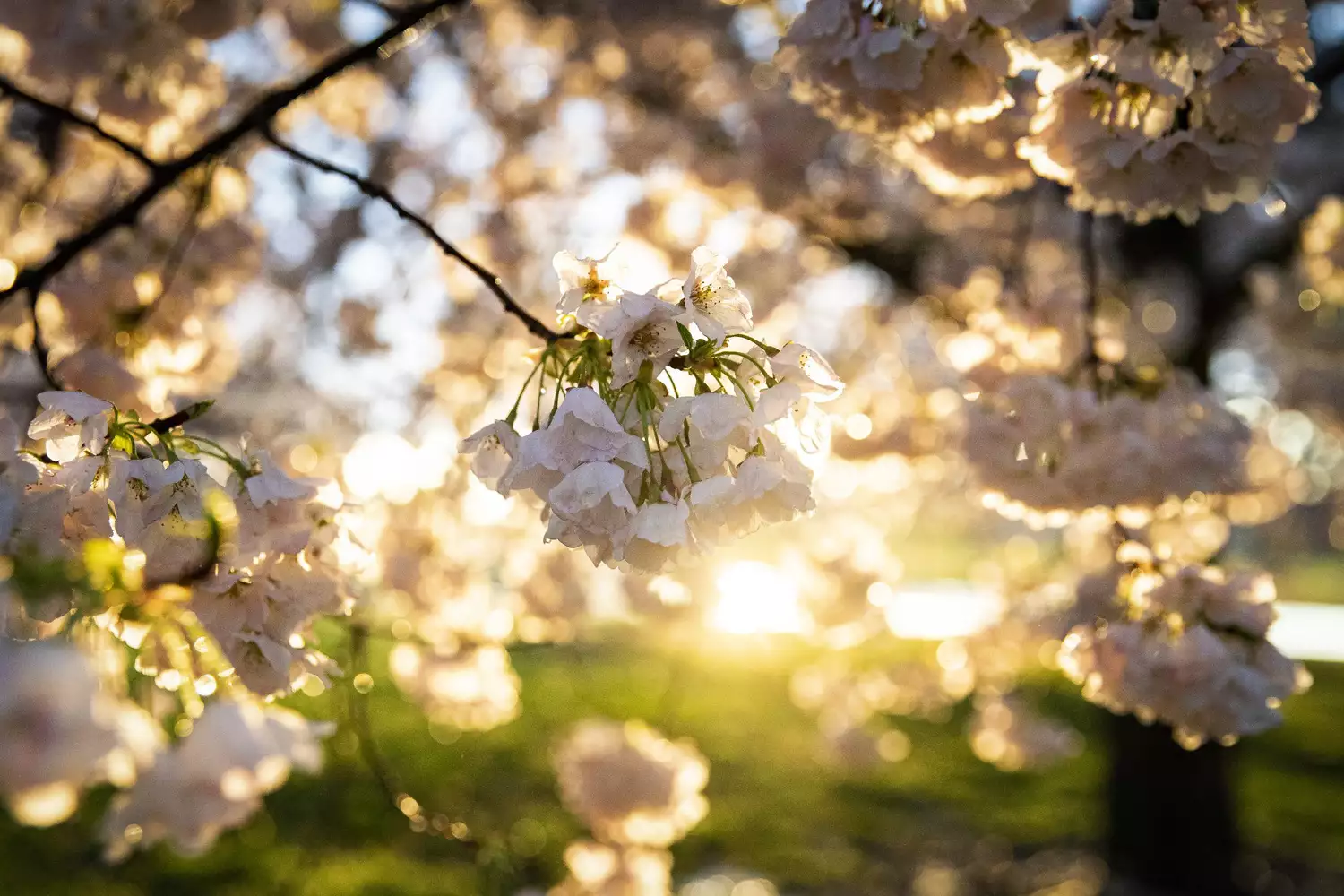
One thing homeowners should consider before planting a new tree is determining how tall and wide it will grow. Oversized trees not suitable for smaller environments hide windows, block driveways, crack sidewalks, ruin lawns, and can even fall on your home during a storm. There is no need to risk these landscaping conditions when various smaller trees beautify your yards and win compliments from neighbors. Here are some of the best tree options for small yards and what season you can expect them to bloom.
Summer Blooms
Japanese Maple
When someone says, “I need a small tree for a small space,” my first thought is always of Japanese Maples. Why? These slow-growing trees are reliable, come in an astounding variety of shapes, sizes, and colors, and offer vivid bright scarlet, crimson, orange, and yellow fall foliage. Most reach a height of 15 feet or less and take a long while to get there. Consider ‘Bloodgood’ (15 feet tall), ‘Crimson Queen’ (four to six feet), ‘Emperor 1’ (15 feet), and ‘Fireglow’ (12 feet).
- Botanical Name: Acer palmatum
- Sun Exposure: Full, Partial
- Soil Type: Moist, Well-drained
- Soil pH: Acidic (5.5 to 6.5)
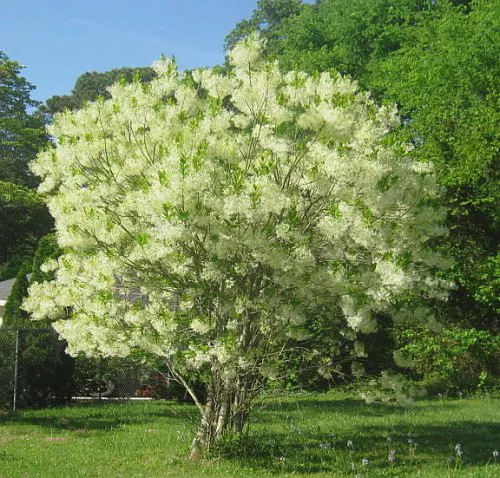
Fringe Tree
This lovely native tree, offering fleecy, white flowers in spring and bright yellow fall foliage, makes a good substitute for a flowering dogwood if your yard doesn’t support those trees. Also known as ‘Grancy Graybeard,’ Fringe Trees grow about 15 feet tall and wide. In colder climates, these trees appear more like shrubs. In the South, it’s pest-free but susceptible to emerald ash borer, a beetle that feeds on species of ash trees.
- Botanical Name: Chionanthus virginicus
- Sun Exposure: Full, Partial
- Soil Type: Clay, Loamy, Well-drained, Moist
- Soil pH: Acidic (6.0 to 6.5)
Summer To Fall Blooms
Shorter Crepe Myrtles
Instead of planting the very tall “Natchez’ crepe myrtle, try a Shorter Crepe Myrtle as an alternative. Plant a selection that doesn’t grow very big, so you won’t have to trim branches later. Some varieties include ‘Acoma’ (white flowers, six to 10 feet tall), ‘Early Bird’ (white or purple, six to eight feet), ‘Siren Red’ (dark red, eight to 10 feet tall), ‘Velma’s Royal Delight’ (rich purple, four to six feet), and ‘Zuni’ (lavender, six to 10 feet).
- Botanical Name: Lagerstroemia indica
- Sun Exposure: Full
- Soil Type: Clay, Sandy, Well-drained, Moist
- Soil pH: Acidic (6.0 to 6.5)
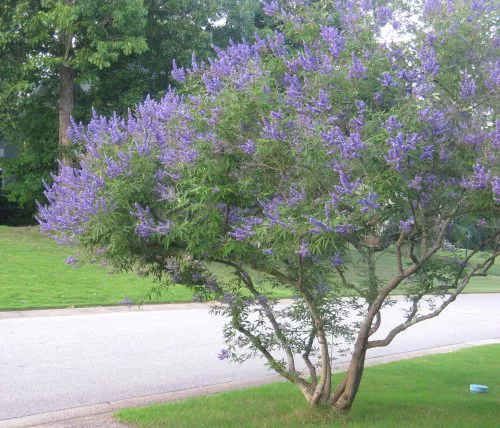
Chaste Tree
A Chaste Tree is one of the few that presents a show-stopping blue or purple flower in summer. These trees need pruning in the winter to remove the internal twigs and let the sculptural trunks show. It blooms on new growth, so winter pruning is good for it. Remove the first wave of flowers to see the second wave of blooms in August or September after the initial colors fade. Chaste Trees are fully winter-hardy and may return to bloom from the roots.
- Botanical Name: Vitex agnus-castus
- Sun Exposure: Full
- Soil Type: Loose, Well-drained
- Soil pH: Acidic to Neutral (6.0 to 7.0)
Fall Blooms
Witch Hazel
Known for its medicinal purposes, Witch Hazel thrives mainly in sunlight with moist soil but is forgiving of most growing conditions. Witch Hazel, or Winterbloom, matures into shapely shrubs that bloom annually. This maintenance-free option grows to a height of 20 feet with a similar width. This tree has brilliant autumn foliage as well as yellow-orange blooms.
- Botanical Name: Hamamelis
- Sun Exposure: Full, Partial
- Soil Type: Well-drained, Moist, Loamy, Rich, Sandy
- Soil pH: Acidic to Neutral to Alkaline (5.0 to 7.4)
Powder Puff Trees
These trees are excellent for warmer climates and have multiple blooms throughout the year. As one of the trees that bloom in fall and winter, this tree’s leaves emerge a shade of pink and evolve to a darker green and sprout flower heads. The size of Power Puff trees can be controlled by continuous trimming, even by moving them to an indoor location to avoid harsh winter climates. Trims also help contain the dense shape.
- Botanical Name: Calliandra haematocephala
- Sun Exposure: Full, Partial
- Soil Type: Well-drained, Moist, Fertile
- Soil pH: Acidic to Neutral to Alkaline (6.0 to 7.5)
Spring Blooms
Serviceberry
Also known by various names, including shadbush, juneberry, and sugarplum, this small, rounded tree blooms in early spring, depending on location. Characteristic of its name, in early summer, this tree or shrub produces a berry-like fruit that matures to a purplish color. White flower blooms in spring form clusters, and radiant leaves emerge in autumn.
- Botanical Name: Amelanchier arborea
- Sun Exposure: Full, Partial
- Soil Type: Well-drained, Moist, Fertile, Clay, Sandy
- Soil pH: Acidic to Neutral (5.5 to 7.0)
Cherry Blossom
The Cherry Blossom tree symbolizes springtime and peace in the U.S. Originally gifted by Japan, the pink and white blooms are short-lived, usually peaking for around two weeks. These trees can grow in yards with varying levels of sunlight, so they might be a good choice for some homeowners. Despite the short bloom, Cherry Blossoms also have excellent fall foliage and require little maintenance.
- Botanical Name: Prunus serrulata
- Sun Exposure: Full, Partial
- Soil Type: Well-drained, Rich, Fertile, Sandy, Loamy, Clay
- Soil pH: Acidic (6.5)
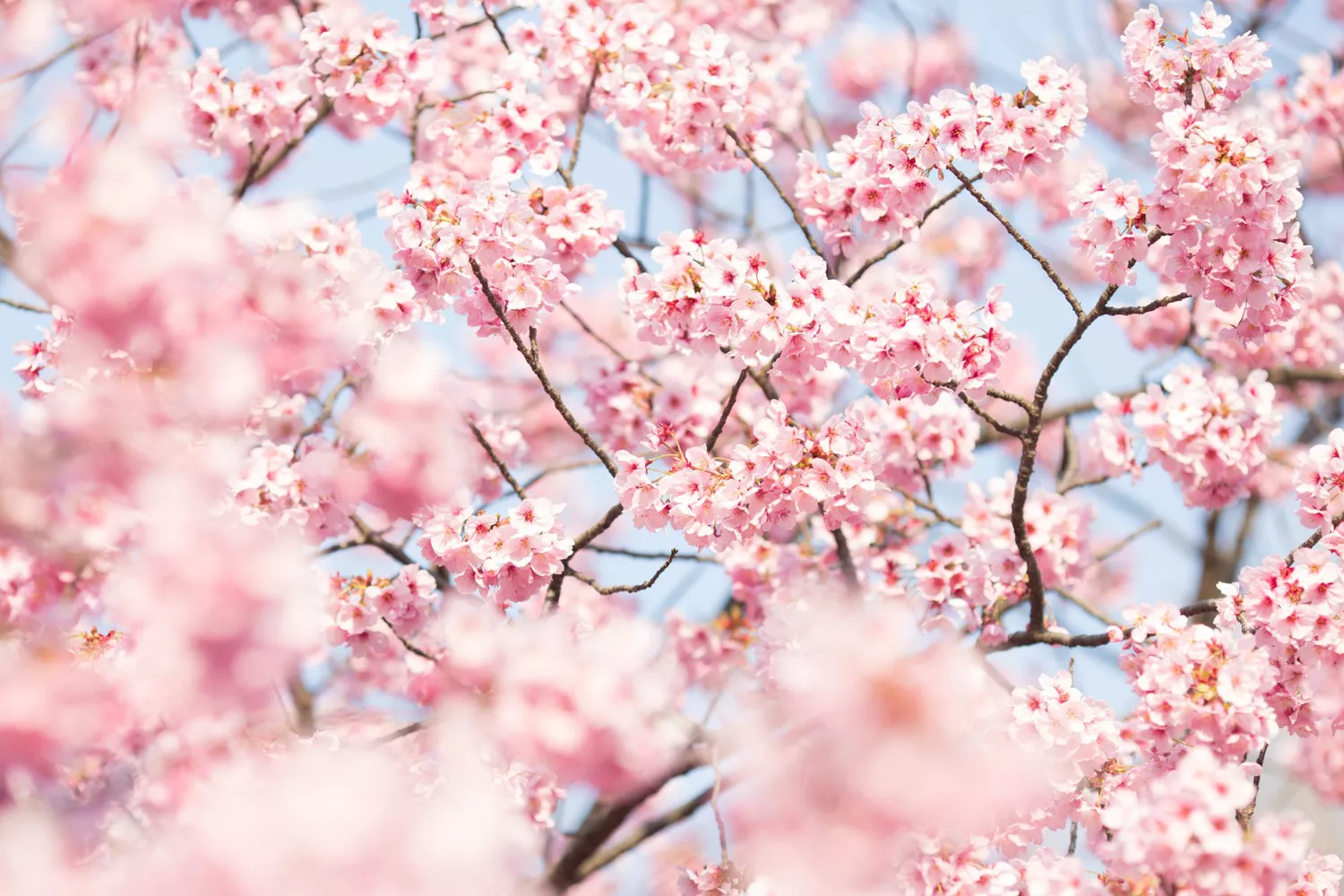
“Little Girl” Magnolias
These tree hybrids display magnificent deep-pink to reddish-purple flowers late enough in spring that frosts seldom damage them. They grow around 15 feet tall and open a few four-to-six-inch flowers throughout the summer. Popular varieties include ‘Ann,’ ‘Jane,’ and ‘Susan.’
- Botanical Name: Magnolia liliflora x M. stellata
- Sun Exposure: Full, Partial
- Soil Type: Well-drained, Loamy, Moist
- Soil pH: Acidic (5.0 to 6.0)
Hedge Maple
This deciduous tree, commonly found in urban environments, is known as the Common Maple or Field Maple. The Hedge Maple is adaptable to many growing environments, including periods of drought, occasional partial sunlight, and air pollution, making it easy to maintain. Creating a sturdy structure, and trimming excess branches, allows this tree to thrive.
- Botanical Name: Acer campestre
- Sun Exposure: Full, Partial
- Soil Type: Well-drained, Rich
- Soil pH: Acidic to Neutral to Alkaline (5.5 to 8.0)
Spring To Summer Blooms
Viburnum Trees
A popular tree for landscaping, this flowering shrub typically blooms in early spring through early summer. There are various Viburnum species, some with white or pink flowers and others with unique foliage. Be sure where you plant this tree as it does not prefer transplantation, but it will thrive in most growing environments—one of the more common species is the ‘Snowball’ Viburnum, named for the white, snowball-shaped blooms. Pruning is typically reserved for shaping preferences but can also help remove dead branches or excess foliage.
- Botanical Name: Viburnum spp.
- Sun Exposure: Full, Partial
- Soil Type: Well-drained, Moist
- Soil pH: Acidic (5.5 to 6.5)
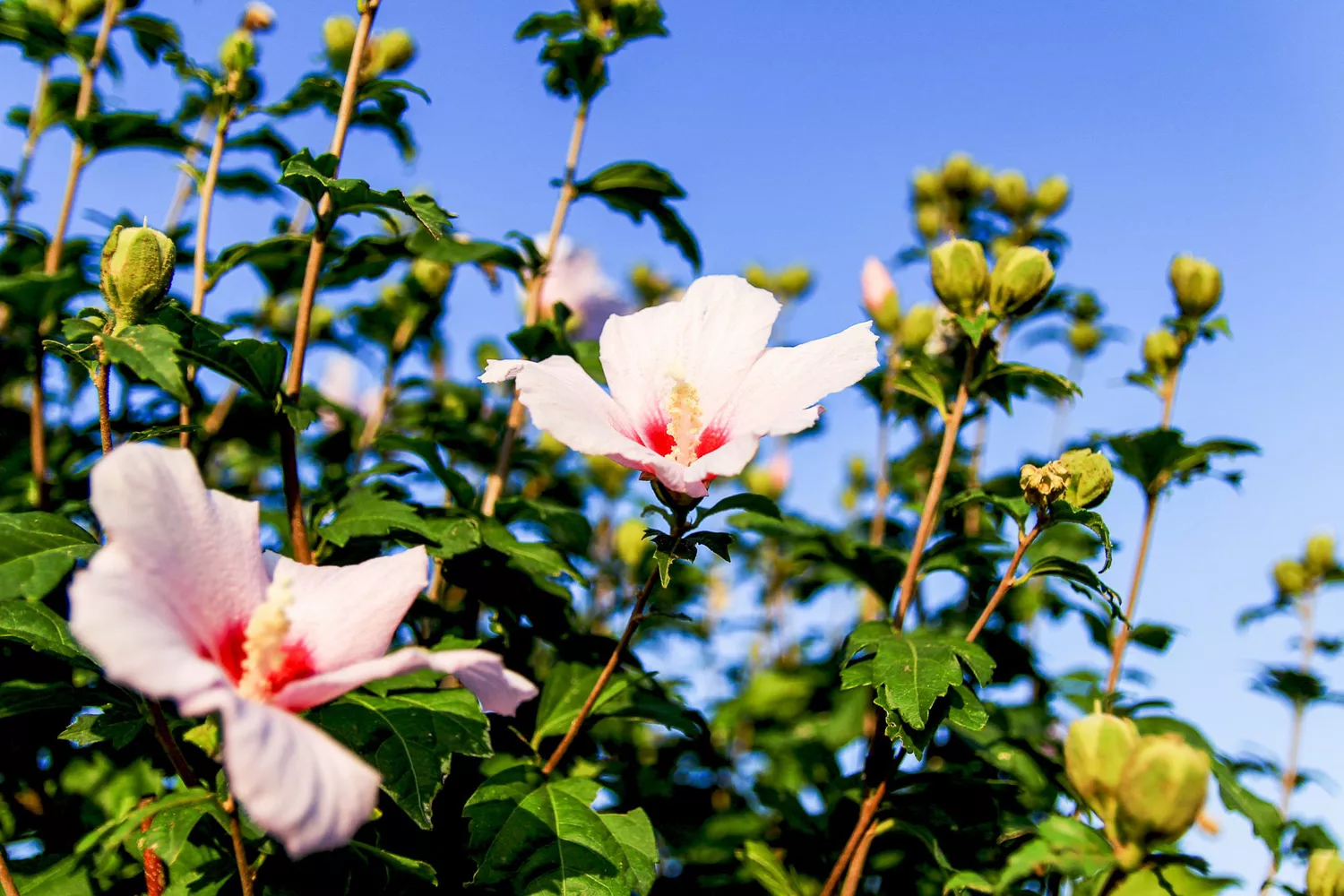
Spring To Fall Blooms
Rose-of-Sharon
Today’s improved hybrids of this tree feature flowers over an extended period, more colors, fewer seeds, and better shapes. Blooming on new growth, they reach up to 12 feet. Varieties include ‘Ardens’ (double lilac-purple flowers), ‘Blue Chiffon’ (blue with a ruffled center), ‘Blue Satin’ (blue with a red center), and ‘Blushing Bride’ (double white).
- Botanical Name: Hibiscus syriacus
- Sun Exposure: Full, Partial, Indirect
- Soil Type: Well-drained
- Soil pH: Acidic to Neutral to Alkaline (5.5 to 7.5)





